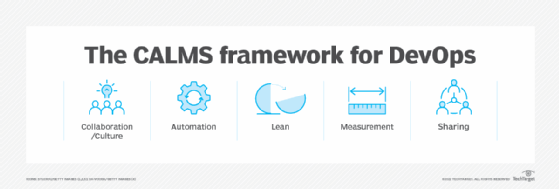
Khunatorn - stock.adobe.com
5 best practices for building a strong DevOps culture
Under the CALMS framework, establishing an open, collaborative culture from the outset is just as important as tools and technologies when starting out on your DevOps journey.
In the 15 years since DevOps was first conceptualized, an entire industry has sprung up focused on technologies and tools for DevOps teams. But without a solid approach to nurturing the human aspect of DevOps, the methodology is bound to fail.
The CALMS framework acts as a guide for organizations looking to make the transition to DevOps from other models. The framework's five elements -- collaboration or culture, automation, lean, measurement, and sharing -- can help organizations better understand their DevOps process and progress.
To start your CALMS journey and set your organization up for success, focus first on what's arguably the most important aspect of DevOps: the teams and people who will be part of the DevOps transition.
Creating a DevOps culture
DevOps breaks down silos between development and IT operations so that they can carry out tasks to meet business needs under a shared approach. DevOps is not a technology, and a DevOps transition does not occur simply through using certain tools. Instead, implementing the DevOps methodology takes time, dedication and constant reevaluation.
All five facets of the CALMS framework are closely interrelated. Without a strong foundation of culture and collaboration, the other areas will suffer. Organizations should focus on strengthening the relationship between IT teams and management from the beginning with clear communication and planning to avoid missteps.

To help establish a strong DevOps culture, instate the following best practices from day one.
1. Open the floor for honest communication
DevOps is nothing without clear and open conversations. Creating a safe environment for candid discussions will accelerate your DevOps progress by giving team members the opportunity to voice their own opinions, concerns or ideas. Open communication also builds trust, ensuring everyone feels included, valued and comfortable sharing their ideas.
2. Create a common goal
Having a clear plan that outlines where you want to go and how you'll get there can motivate teams and point them in the right direction. Everyone must agree on why DevOps is in place and understand its benefits to ensure success, so set a common goal that everyone works together to meet. But make sure goals are reasonable and achievable so that teams don't lose interest or get disheartened by a lack of progress.
3. Share responsibility and avoid blame
For DevOps to flourish, teams must share responsibility for the initiative. Everyone involved must have a clear idea about what is and isn't working. Establish clear and realistic time frames, budgets and expectations from the start.
Just as important is that under the DevOps approach, no one person or department is to blame when things don't work. Avoid finger-pointing: If teams fail to meet a deadline or something goes wrong, approach it as a learning experience instead of punishing individuals. Conduct blameless postmortems to eliminate the stress and fear often associated with post-incident reviews.
4. Provide transparency about IT decisions
Everyone in the organization -- from stakeholders and management to developers and operations staff -- should understand the DevOps practices in place and the decision-making process. Share information and data collected across all departments to ensure problem-solving is a collective effort.
In addition, transparency fosters trust between teams that might not normally work together. Making sure teams know they have management's support to experiment can accelerate the pace of development on software projects.
5. Supply training on the new methodology
As important as communication is, teams must also receive the right training so that they can achieve the goals set. Don't just push them into DevOps processes immediately and expect to see results. Start with DevOps certifications and training courses to sharpen skills, or host a DevOps Dojo training so that employees can grow together as a team.
View DevOps collaboration as part of the bigger picture
By fostering a culture of collaboration, organizations can solve problems faster, increase productivity and achieve success in their DevOps journey. But organizations cannot achieve growth by focusing only on the community aspect.
At Devopsdays Amsterdam 2019, Jason Yee, staff technical evangelist at Datadog, discussed the benefits of mapping your DevOps journey with the CALMS framework. In his presentation, he compared implementing CALMS to a rubber band: If you pull in one direction by focusing all your time and energy in only one area, tension builds in the other directions.
For example, if an organization focuses only on automation or adopting tools in its DevOps approach, establishing a culture of collaboration and sharing can be challenging. Similarly, Yee said, companies with a strong culture can get very entrenched in their processes, which can make it hard to stay lean and evolve.
Instead of putting all your effort into one facet of the CALMS framework, remember to keep the big picture in mind when working toward DevOps implementation. View the CALMS framework as a circular process in which each element feeds into the others to support collective success.






